Essay on Mental Health: Seclusion and Restraint Impact in Australia
VerifiedAdded on 2022/08/27
|12
|3341
|35
Essay
AI Summary
This essay delves into the critical issue of seclusion and restraint practices within the Australian mental health system. It examines the detrimental effects of these interventions on both consumers and healthcare professionals, highlighting violations of human rights, trauma, and the disruption of therapeutic relationships. The essay provides a comprehensive overview of the impact on consumers, including the experience of trauma, dehumanization, and isolation, as well as the impact on healthcare professionals. It further evaluates the role of registered nurses in collaborating with national and territorial initiatives to reduce the use of seclusion and restraint, advocating for trauma-informed care, recovery-oriented approaches, and the promotion of safe and empowering environments within mental health services. The essay concludes by emphasizing the need for a shift towards compassionate, ethical, and patient-centered care to foster recovery and improve the well-being of individuals experiencing mental health challenges.
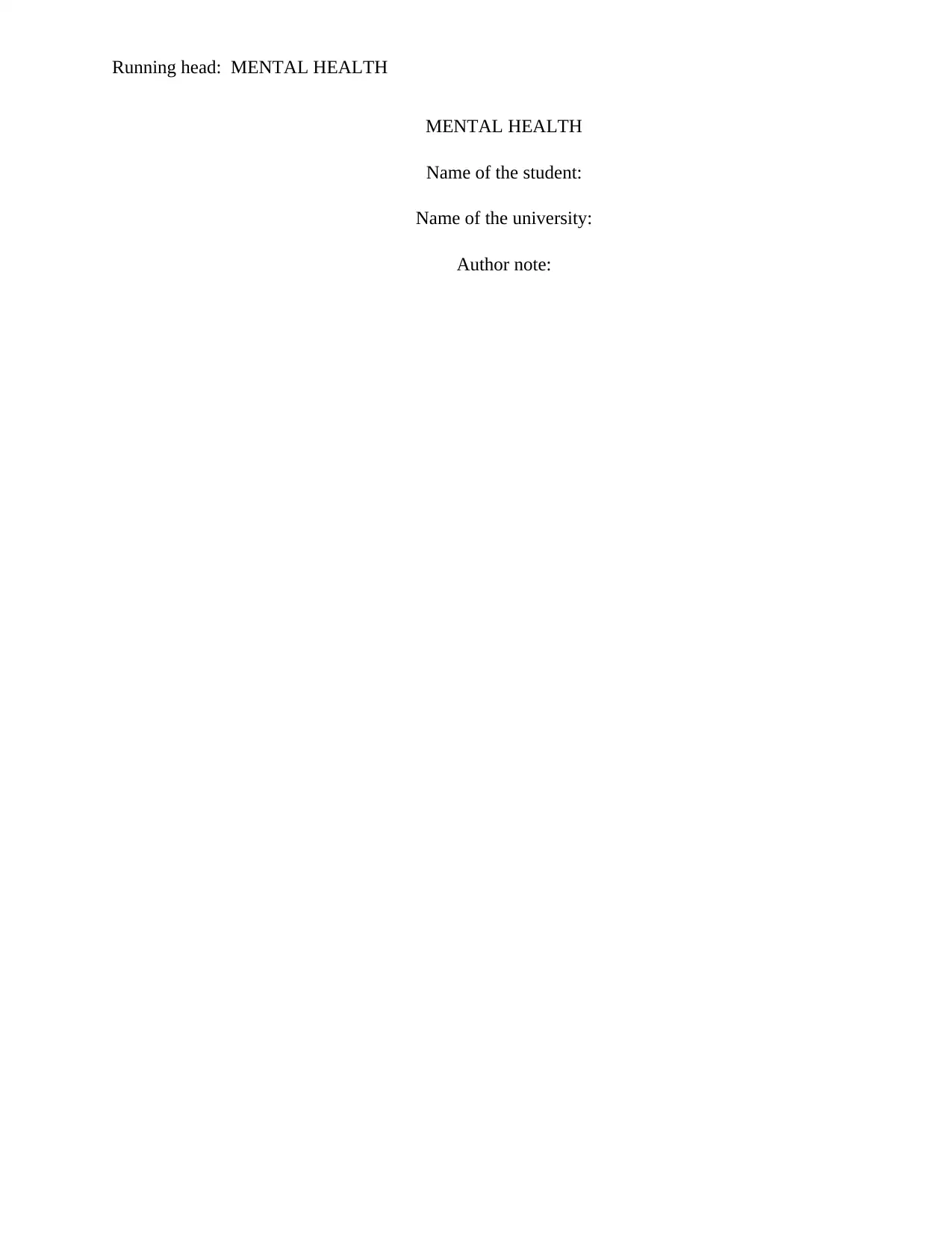
Running head: MENTAL HEALTH
MENTAL HEALTH
Name of the student:
Name of the university:
Author note:
MENTAL HEALTH
Name of the student:
Name of the university:
Author note:
Paraphrase This Document
Need a fresh take? Get an instant paraphrase of this document with our AI Paraphraser
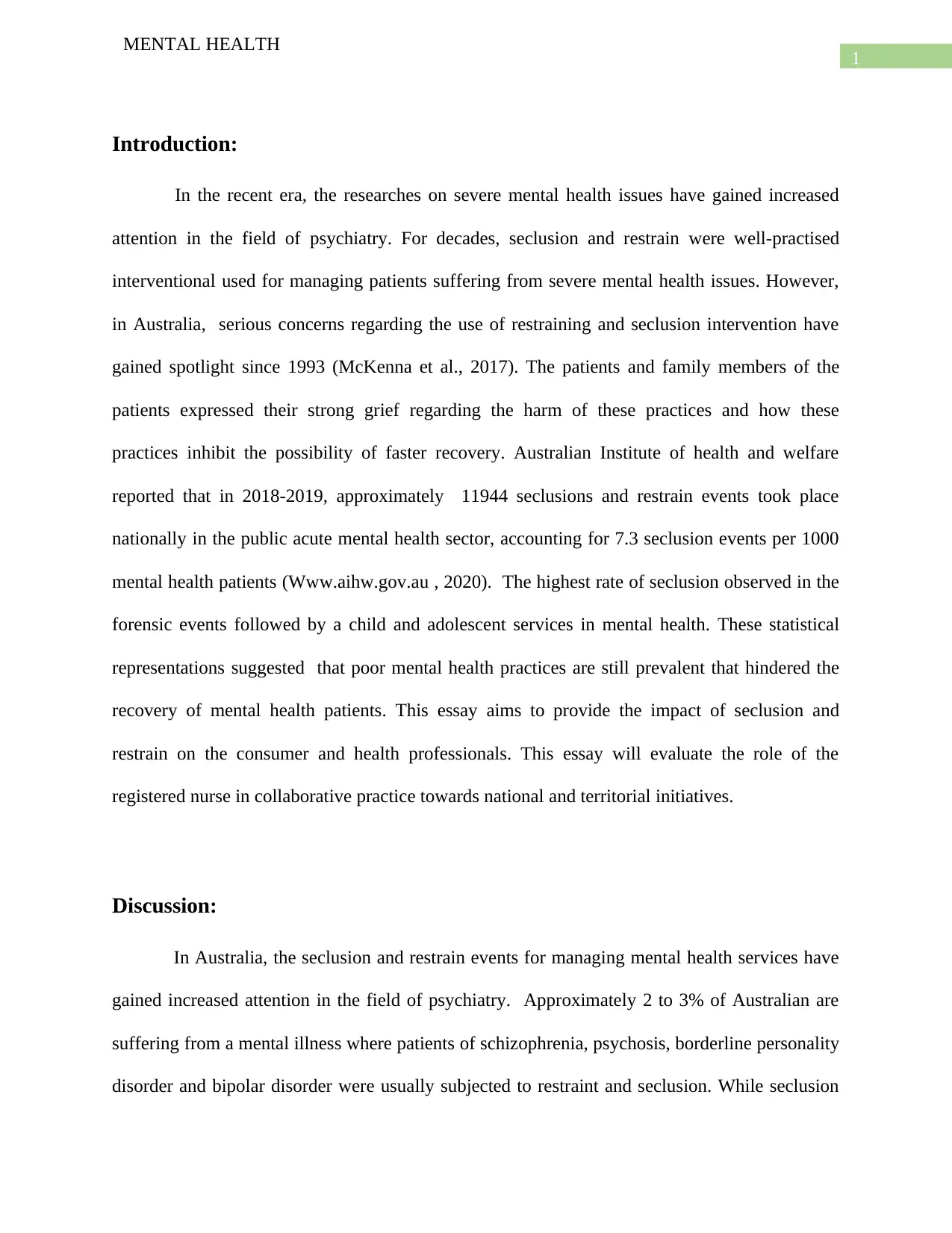
1
MENTAL HEALTH
Introduction:
In the recent era, the researches on severe mental health issues have gained increased
attention in the field of psychiatry. For decades, seclusion and restrain were well-practised
interventional used for managing patients suffering from severe mental health issues. However,
in Australia, serious concerns regarding the use of restraining and seclusion intervention have
gained spotlight since 1993 (McKenna et al., 2017). The patients and family members of the
patients expressed their strong grief regarding the harm of these practices and how these
practices inhibit the possibility of faster recovery. Australian Institute of health and welfare
reported that in 2018-2019, approximately 11944 seclusions and restrain events took place
nationally in the public acute mental health sector, accounting for 7.3 seclusion events per 1000
mental health patients (Www.aihw.gov.au , 2020). The highest rate of seclusion observed in the
forensic events followed by a child and adolescent services in mental health. These statistical
representations suggested that poor mental health practices are still prevalent that hindered the
recovery of mental health patients. This essay aims to provide the impact of seclusion and
restrain on the consumer and health professionals. This essay will evaluate the role of the
registered nurse in collaborative practice towards national and territorial initiatives.
Discussion:
In Australia, the seclusion and restrain events for managing mental health services have
gained increased attention in the field of psychiatry. Approximately 2 to 3% of Australian are
suffering from a mental illness where patients of schizophrenia, psychosis, borderline personality
disorder and bipolar disorder were usually subjected to restraint and seclusion. While seclusion
MENTAL HEALTH
Introduction:
In the recent era, the researches on severe mental health issues have gained increased
attention in the field of psychiatry. For decades, seclusion and restrain were well-practised
interventional used for managing patients suffering from severe mental health issues. However,
in Australia, serious concerns regarding the use of restraining and seclusion intervention have
gained spotlight since 1993 (McKenna et al., 2017). The patients and family members of the
patients expressed their strong grief regarding the harm of these practices and how these
practices inhibit the possibility of faster recovery. Australian Institute of health and welfare
reported that in 2018-2019, approximately 11944 seclusions and restrain events took place
nationally in the public acute mental health sector, accounting for 7.3 seclusion events per 1000
mental health patients (Www.aihw.gov.au , 2020). The highest rate of seclusion observed in the
forensic events followed by a child and adolescent services in mental health. These statistical
representations suggested that poor mental health practices are still prevalent that hindered the
recovery of mental health patients. This essay aims to provide the impact of seclusion and
restrain on the consumer and health professionals. This essay will evaluate the role of the
registered nurse in collaborative practice towards national and territorial initiatives.
Discussion:
In Australia, the seclusion and restrain events for managing mental health services have
gained increased attention in the field of psychiatry. Approximately 2 to 3% of Australian are
suffering from a mental illness where patients of schizophrenia, psychosis, borderline personality
disorder and bipolar disorder were usually subjected to restraint and seclusion. While seclusion
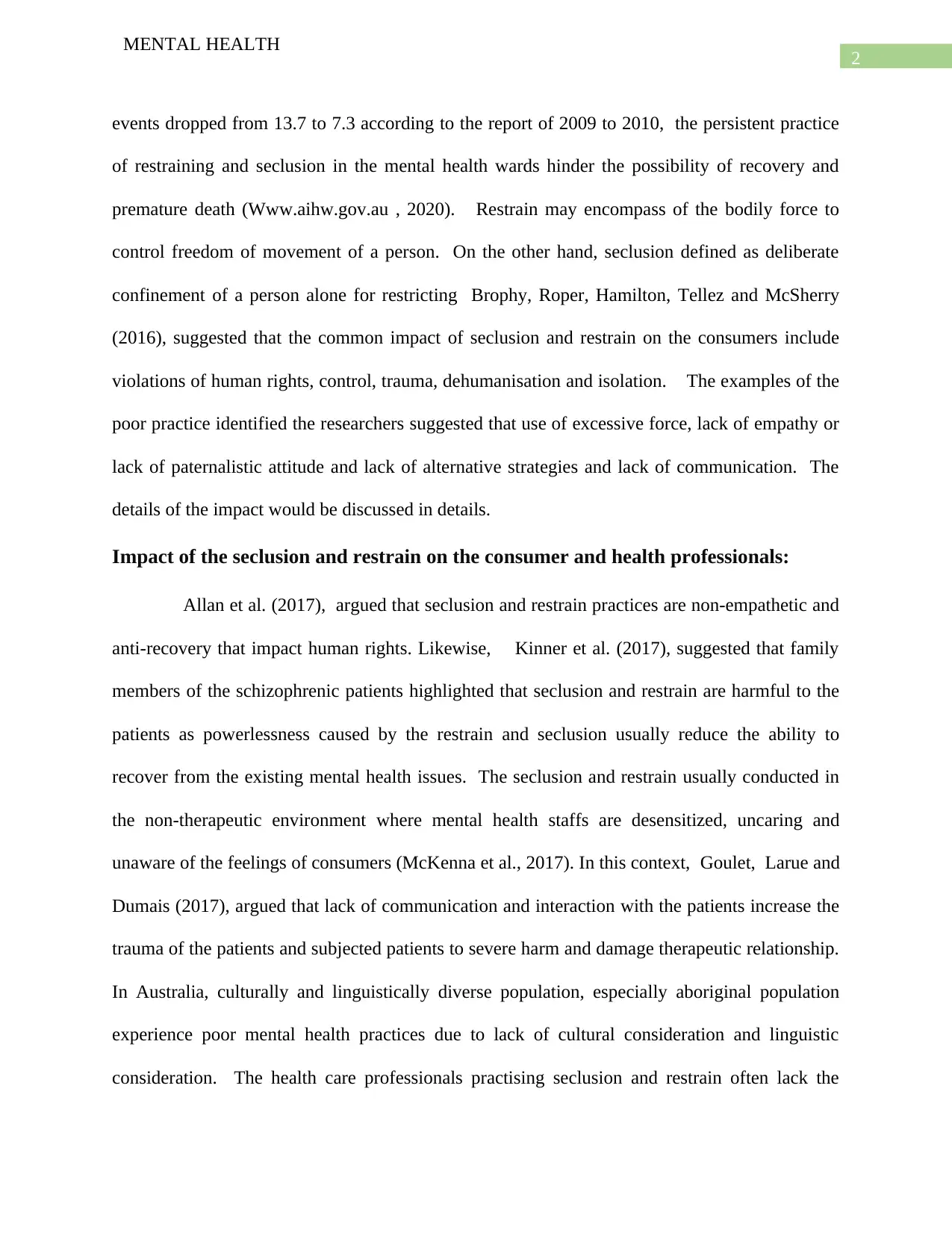
2
MENTAL HEALTH
events dropped from 13.7 to 7.3 according to the report of 2009 to 2010, the persistent practice
of restraining and seclusion in the mental health wards hinder the possibility of recovery and
premature death (Www.aihw.gov.au , 2020). Restrain may encompass of the bodily force to
control freedom of movement of a person. On the other hand, seclusion defined as deliberate
confinement of a person alone for restricting Brophy, Roper, Hamilton, Tellez and McSherry
(2016), suggested that the common impact of seclusion and restrain on the consumers include
violations of human rights, control, trauma, dehumanisation and isolation. The examples of the
poor practice identified the researchers suggested that use of excessive force, lack of empathy or
lack of paternalistic attitude and lack of alternative strategies and lack of communication. The
details of the impact would be discussed in details.
Impact of the seclusion and restrain on the consumer and health professionals:
Allan et al. (2017), argued that seclusion and restrain practices are non-empathetic and
anti-recovery that impact human rights. Likewise, Kinner et al. (2017), suggested that family
members of the schizophrenic patients highlighted that seclusion and restrain are harmful to the
patients as powerlessness caused by the restrain and seclusion usually reduce the ability to
recover from the existing mental health issues. The seclusion and restrain usually conducted in
the non-therapeutic environment where mental health staffs are desensitized, uncaring and
unaware of the feelings of consumers (McKenna et al., 2017). In this context, Goulet, Larue and
Dumais (2017), argued that lack of communication and interaction with the patients increase the
trauma of the patients and subjected patients to severe harm and damage therapeutic relationship.
In Australia, culturally and linguistically diverse population, especially aboriginal population
experience poor mental health practices due to lack of cultural consideration and linguistic
consideration. The health care professionals practising seclusion and restrain often lack the
MENTAL HEALTH
events dropped from 13.7 to 7.3 according to the report of 2009 to 2010, the persistent practice
of restraining and seclusion in the mental health wards hinder the possibility of recovery and
premature death (Www.aihw.gov.au , 2020). Restrain may encompass of the bodily force to
control freedom of movement of a person. On the other hand, seclusion defined as deliberate
confinement of a person alone for restricting Brophy, Roper, Hamilton, Tellez and McSherry
(2016), suggested that the common impact of seclusion and restrain on the consumers include
violations of human rights, control, trauma, dehumanisation and isolation. The examples of the
poor practice identified the researchers suggested that use of excessive force, lack of empathy or
lack of paternalistic attitude and lack of alternative strategies and lack of communication. The
details of the impact would be discussed in details.
Impact of the seclusion and restrain on the consumer and health professionals:
Allan et al. (2017), argued that seclusion and restrain practices are non-empathetic and
anti-recovery that impact human rights. Likewise, Kinner et al. (2017), suggested that family
members of the schizophrenic patients highlighted that seclusion and restrain are harmful to the
patients as powerlessness caused by the restrain and seclusion usually reduce the ability to
recover from the existing mental health issues. The seclusion and restrain usually conducted in
the non-therapeutic environment where mental health staffs are desensitized, uncaring and
unaware of the feelings of consumers (McKenna et al., 2017). In this context, Goulet, Larue and
Dumais (2017), argued that lack of communication and interaction with the patients increase the
trauma of the patients and subjected patients to severe harm and damage therapeutic relationship.
In Australia, culturally and linguistically diverse population, especially aboriginal population
experience poor mental health practices due to lack of cultural consideration and linguistic
consideration. The health care professionals practising seclusion and restrain often lack the
⊘ This is a preview!⊘
Do you want full access?
Subscribe today to unlock all pages.

Trusted by 1+ million students worldwide
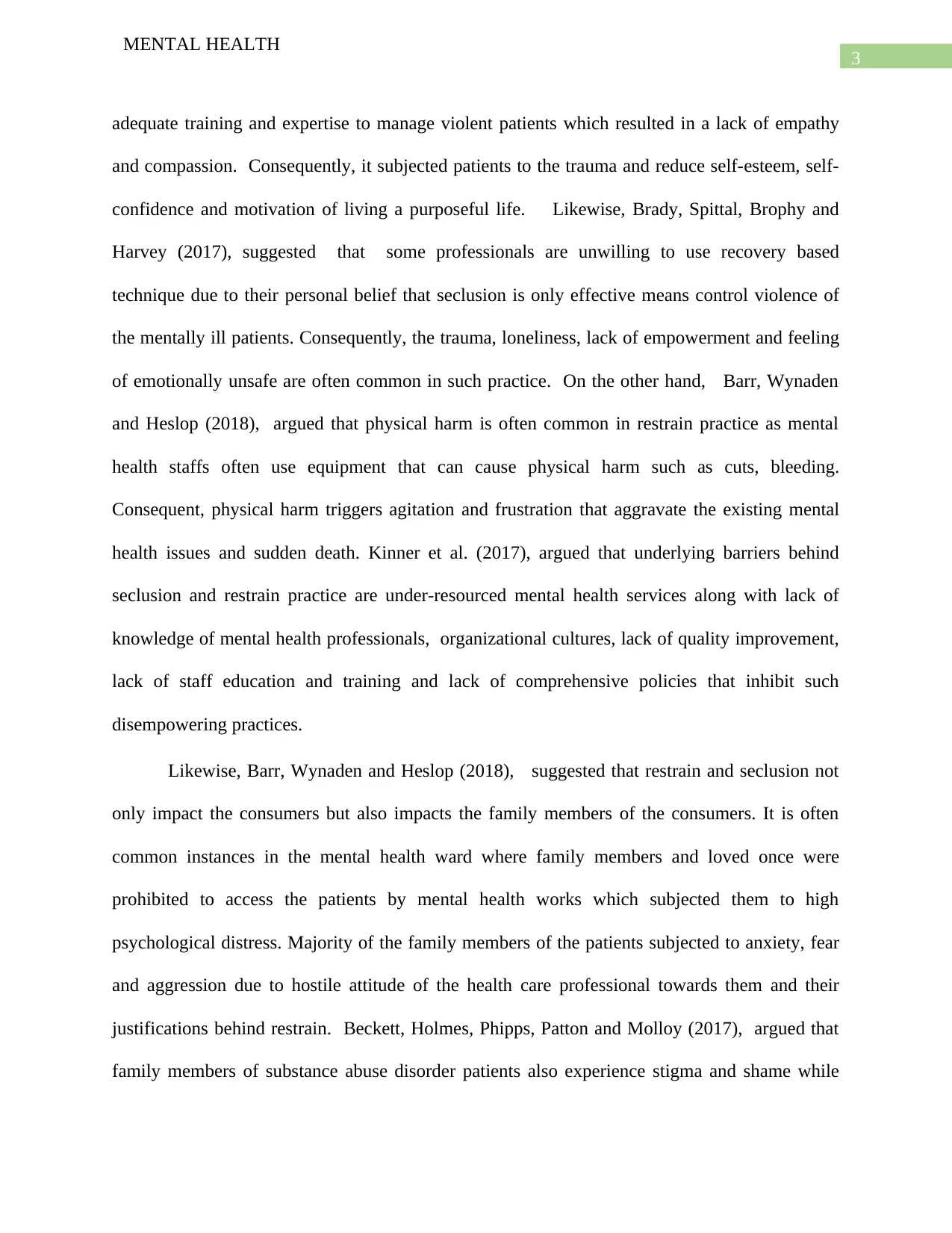
3
MENTAL HEALTH
adequate training and expertise to manage violent patients which resulted in a lack of empathy
and compassion. Consequently, it subjected patients to the trauma and reduce self-esteem, self-
confidence and motivation of living a purposeful life. Likewise, Brady, Spittal, Brophy and
Harvey (2017), suggested that some professionals are unwilling to use recovery based
technique due to their personal belief that seclusion is only effective means control violence of
the mentally ill patients. Consequently, the trauma, loneliness, lack of empowerment and feeling
of emotionally unsafe are often common in such practice. On the other hand, Barr, Wynaden
and Heslop (2018), argued that physical harm is often common in restrain practice as mental
health staffs often use equipment that can cause physical harm such as cuts, bleeding.
Consequent, physical harm triggers agitation and frustration that aggravate the existing mental
health issues and sudden death. Kinner et al. (2017), argued that underlying barriers behind
seclusion and restrain practice are under-resourced mental health services along with lack of
knowledge of mental health professionals, organizational cultures, lack of quality improvement,
lack of staff education and training and lack of comprehensive policies that inhibit such
disempowering practices.
Likewise, Barr, Wynaden and Heslop (2018), suggested that restrain and seclusion not
only impact the consumers but also impacts the family members of the consumers. It is often
common instances in the mental health ward where family members and loved once were
prohibited to access the patients by mental health works which subjected them to high
psychological distress. Majority of the family members of the patients subjected to anxiety, fear
and aggression due to hostile attitude of the health care professional towards them and their
justifications behind restrain. Beckett, Holmes, Phipps, Patton and Molloy (2017), argued that
family members of substance abuse disorder patients also experience stigma and shame while
MENTAL HEALTH
adequate training and expertise to manage violent patients which resulted in a lack of empathy
and compassion. Consequently, it subjected patients to the trauma and reduce self-esteem, self-
confidence and motivation of living a purposeful life. Likewise, Brady, Spittal, Brophy and
Harvey (2017), suggested that some professionals are unwilling to use recovery based
technique due to their personal belief that seclusion is only effective means control violence of
the mentally ill patients. Consequently, the trauma, loneliness, lack of empowerment and feeling
of emotionally unsafe are often common in such practice. On the other hand, Barr, Wynaden
and Heslop (2018), argued that physical harm is often common in restrain practice as mental
health staffs often use equipment that can cause physical harm such as cuts, bleeding.
Consequent, physical harm triggers agitation and frustration that aggravate the existing mental
health issues and sudden death. Kinner et al. (2017), argued that underlying barriers behind
seclusion and restrain practice are under-resourced mental health services along with lack of
knowledge of mental health professionals, organizational cultures, lack of quality improvement,
lack of staff education and training and lack of comprehensive policies that inhibit such
disempowering practices.
Likewise, Barr, Wynaden and Heslop (2018), suggested that restrain and seclusion not
only impact the consumers but also impacts the family members of the consumers. It is often
common instances in the mental health ward where family members and loved once were
prohibited to access the patients by mental health works which subjected them to high
psychological distress. Majority of the family members of the patients subjected to anxiety, fear
and aggression due to hostile attitude of the health care professional towards them and their
justifications behind restrain. Beckett, Holmes, Phipps, Patton and Molloy (2017), argued that
family members of substance abuse disorder patients also experience stigma and shame while
Paraphrase This Document
Need a fresh take? Get an instant paraphrase of this document with our AI Paraphraser
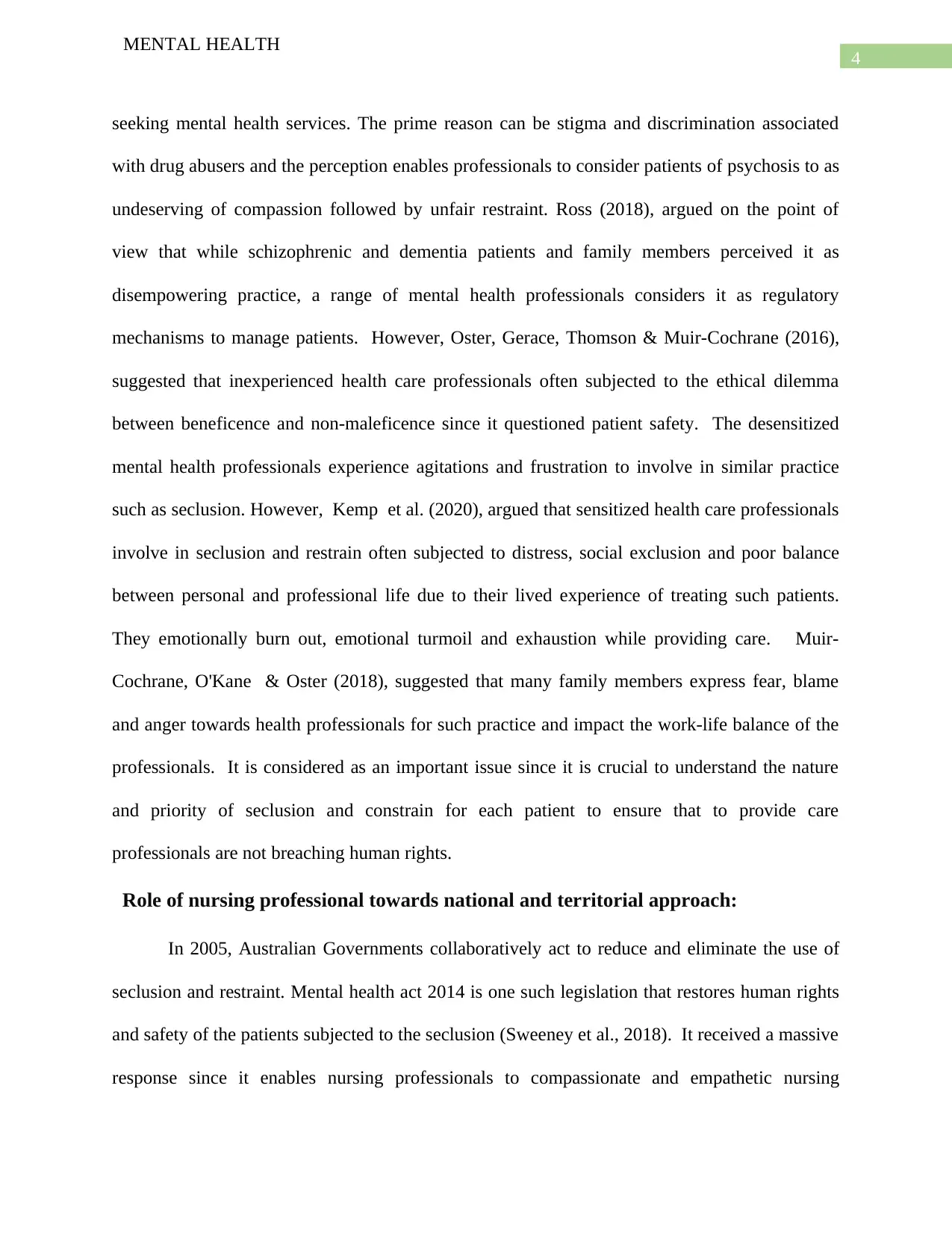
4
MENTAL HEALTH
seeking mental health services. The prime reason can be stigma and discrimination associated
with drug abusers and the perception enables professionals to consider patients of psychosis to as
undeserving of compassion followed by unfair restraint. Ross (2018), argued on the point of
view that while schizophrenic and dementia patients and family members perceived it as
disempowering practice, a range of mental health professionals considers it as regulatory
mechanisms to manage patients. However, Oster, Gerace, Thomson & Muir-Cochrane (2016),
suggested that inexperienced health care professionals often subjected to the ethical dilemma
between beneficence and non-maleficence since it questioned patient safety. The desensitized
mental health professionals experience agitations and frustration to involve in similar practice
such as seclusion. However, Kemp et al. (2020), argued that sensitized health care professionals
involve in seclusion and restrain often subjected to distress, social exclusion and poor balance
between personal and professional life due to their lived experience of treating such patients.
They emotionally burn out, emotional turmoil and exhaustion while providing care. Muir‐
Cochrane, O'Kane & Oster (2018), suggested that many family members express fear, blame
and anger towards health professionals for such practice and impact the work-life balance of the
professionals. It is considered as an important issue since it is crucial to understand the nature
and priority of seclusion and constrain for each patient to ensure that to provide care
professionals are not breaching human rights.
Role of nursing professional towards national and territorial approach:
In 2005, Australian Governments collaboratively act to reduce and eliminate the use of
seclusion and restraint. Mental health act 2014 is one such legislation that restores human rights
and safety of the patients subjected to the seclusion (Sweeney et al., 2018). It received a massive
response since it enables nursing professionals to compassionate and empathetic nursing
MENTAL HEALTH
seeking mental health services. The prime reason can be stigma and discrimination associated
with drug abusers and the perception enables professionals to consider patients of psychosis to as
undeserving of compassion followed by unfair restraint. Ross (2018), argued on the point of
view that while schizophrenic and dementia patients and family members perceived it as
disempowering practice, a range of mental health professionals considers it as regulatory
mechanisms to manage patients. However, Oster, Gerace, Thomson & Muir-Cochrane (2016),
suggested that inexperienced health care professionals often subjected to the ethical dilemma
between beneficence and non-maleficence since it questioned patient safety. The desensitized
mental health professionals experience agitations and frustration to involve in similar practice
such as seclusion. However, Kemp et al. (2020), argued that sensitized health care professionals
involve in seclusion and restrain often subjected to distress, social exclusion and poor balance
between personal and professional life due to their lived experience of treating such patients.
They emotionally burn out, emotional turmoil and exhaustion while providing care. Muir‐
Cochrane, O'Kane & Oster (2018), suggested that many family members express fear, blame
and anger towards health professionals for such practice and impact the work-life balance of the
professionals. It is considered as an important issue since it is crucial to understand the nature
and priority of seclusion and constrain for each patient to ensure that to provide care
professionals are not breaching human rights.
Role of nursing professional towards national and territorial approach:
In 2005, Australian Governments collaboratively act to reduce and eliminate the use of
seclusion and restraint. Mental health act 2014 is one such legislation that restores human rights
and safety of the patients subjected to the seclusion (Sweeney et al., 2018). It received a massive
response since it enables nursing professionals to compassionate and empathetic nursing
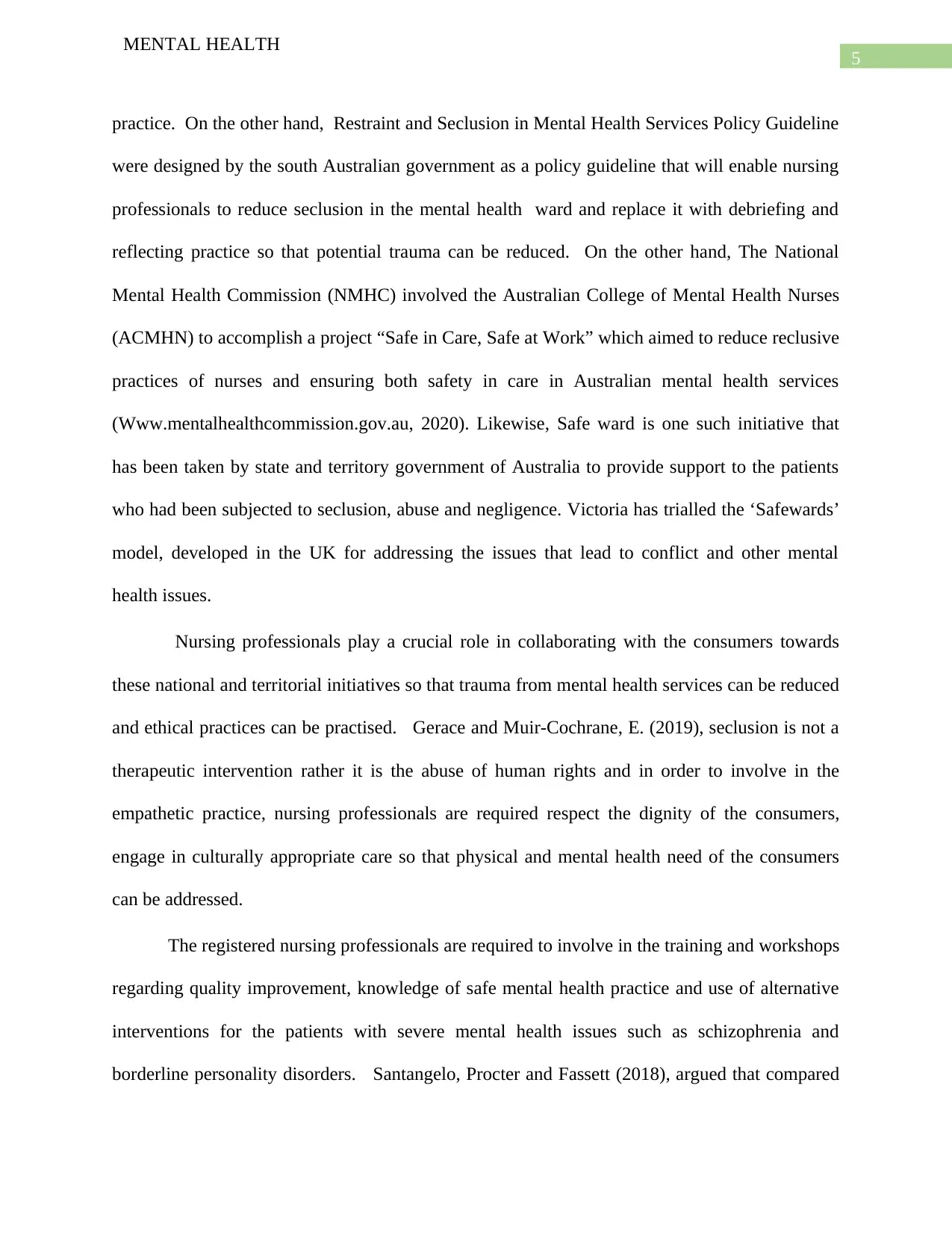
5
MENTAL HEALTH
practice. On the other hand, Restraint and Seclusion in Mental Health Services Policy Guideline
were designed by the south Australian government as a policy guideline that will enable nursing
professionals to reduce seclusion in the mental health ward and replace it with debriefing and
reflecting practice so that potential trauma can be reduced. On the other hand, The National
Mental Health Commission (NMHC) involved the Australian College of Mental Health Nurses
(ACMHN) to accomplish a project “Safe in Care, Safe at Work” which aimed to reduce reclusive
practices of nurses and ensuring both safety in care in Australian mental health services
(Www.mentalhealthcommission.gov.au, 2020). Likewise, Safe ward is one such initiative that
has been taken by state and territory government of Australia to provide support to the patients
who had been subjected to seclusion, abuse and negligence. Victoria has trialled the ‘Safewards’
model, developed in the UK for addressing the issues that lead to conflict and other mental
health issues.
Nursing professionals play a crucial role in collaborating with the consumers towards
these national and territorial initiatives so that trauma from mental health services can be reduced
and ethical practices can be practised. Gerace and Muir‐Cochrane, E. (2019), seclusion is not a
therapeutic intervention rather it is the abuse of human rights and in order to involve in the
empathetic practice, nursing professionals are required respect the dignity of the consumers,
engage in culturally appropriate care so that physical and mental health need of the consumers
can be addressed.
The registered nursing professionals are required to involve in the training and workshops
regarding quality improvement, knowledge of safe mental health practice and use of alternative
interventions for the patients with severe mental health issues such as schizophrenia and
borderline personality disorders. Santangelo, Procter and Fassett (2018), argued that compared
MENTAL HEALTH
practice. On the other hand, Restraint and Seclusion in Mental Health Services Policy Guideline
were designed by the south Australian government as a policy guideline that will enable nursing
professionals to reduce seclusion in the mental health ward and replace it with debriefing and
reflecting practice so that potential trauma can be reduced. On the other hand, The National
Mental Health Commission (NMHC) involved the Australian College of Mental Health Nurses
(ACMHN) to accomplish a project “Safe in Care, Safe at Work” which aimed to reduce reclusive
practices of nurses and ensuring both safety in care in Australian mental health services
(Www.mentalhealthcommission.gov.au, 2020). Likewise, Safe ward is one such initiative that
has been taken by state and territory government of Australia to provide support to the patients
who had been subjected to seclusion, abuse and negligence. Victoria has trialled the ‘Safewards’
model, developed in the UK for addressing the issues that lead to conflict and other mental
health issues.
Nursing professionals play a crucial role in collaborating with the consumers towards
these national and territorial initiatives so that trauma from mental health services can be reduced
and ethical practices can be practised. Gerace and Muir‐Cochrane, E. (2019), seclusion is not a
therapeutic intervention rather it is the abuse of human rights and in order to involve in the
empathetic practice, nursing professionals are required respect the dignity of the consumers,
engage in culturally appropriate care so that physical and mental health need of the consumers
can be addressed.
The registered nursing professionals are required to involve in the training and workshops
regarding quality improvement, knowledge of safe mental health practice and use of alternative
interventions for the patients with severe mental health issues such as schizophrenia and
borderline personality disorders. Santangelo, Procter and Fassett (2018), argued that compared
⊘ This is a preview!⊘
Do you want full access?
Subscribe today to unlock all pages.

Trusted by 1+ million students worldwide
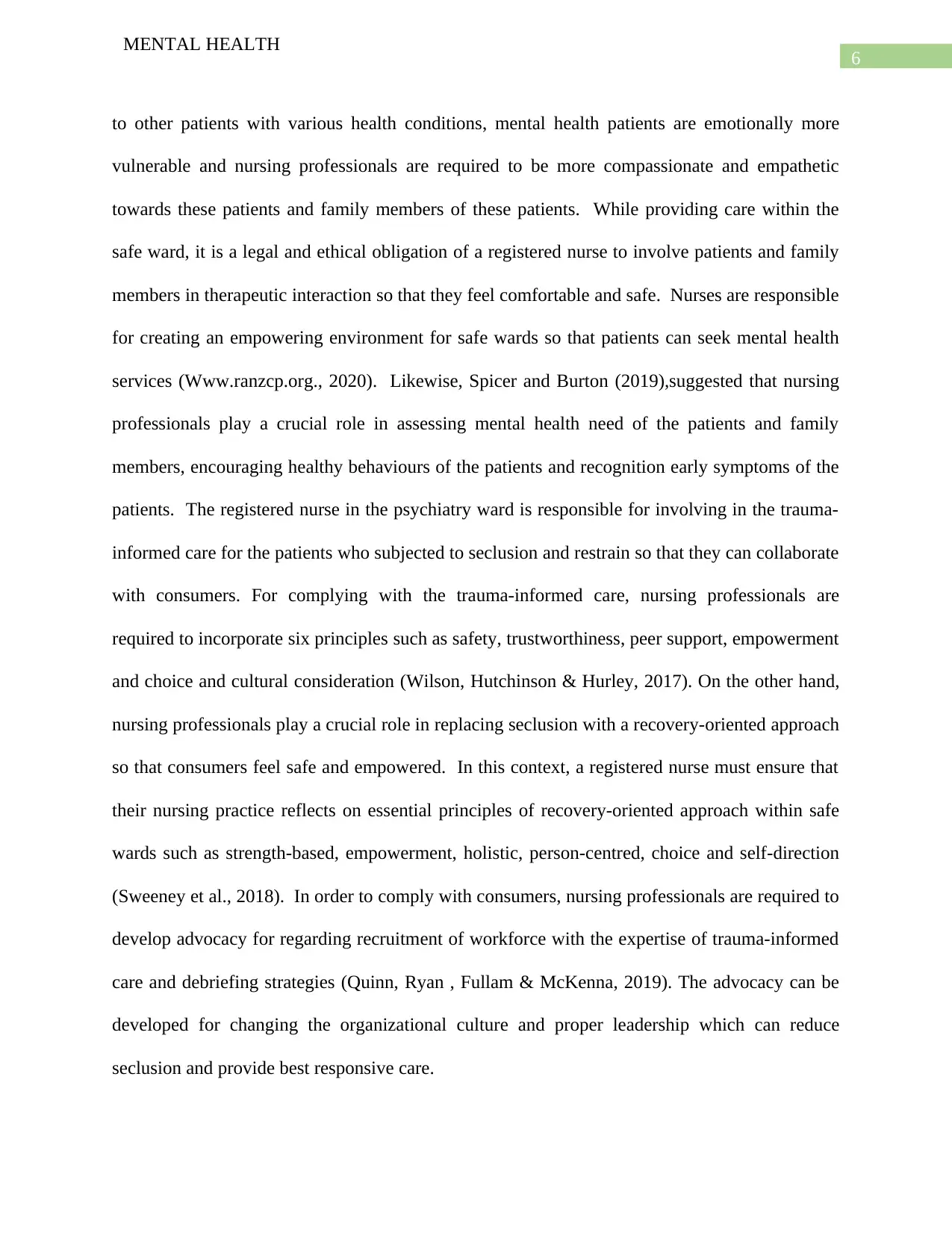
6
MENTAL HEALTH
to other patients with various health conditions, mental health patients are emotionally more
vulnerable and nursing professionals are required to be more compassionate and empathetic
towards these patients and family members of these patients. While providing care within the
safe ward, it is a legal and ethical obligation of a registered nurse to involve patients and family
members in therapeutic interaction so that they feel comfortable and safe. Nurses are responsible
for creating an empowering environment for safe wards so that patients can seek mental health
services (Www.ranzcp.org., 2020). Likewise, Spicer and Burton (2019),suggested that nursing
professionals play a crucial role in assessing mental health need of the patients and family
members, encouraging healthy behaviours of the patients and recognition early symptoms of the
patients. The registered nurse in the psychiatry ward is responsible for involving in the trauma-
informed care for the patients who subjected to seclusion and restrain so that they can collaborate
with consumers. For complying with the trauma-informed care, nursing professionals are
required to incorporate six principles such as safety, trustworthiness, peer support, empowerment
and choice and cultural consideration (Wilson, Hutchinson & Hurley, 2017). On the other hand,
nursing professionals play a crucial role in replacing seclusion with a recovery-oriented approach
so that consumers feel safe and empowered. In this context, a registered nurse must ensure that
their nursing practice reflects on essential principles of recovery-oriented approach within safe
wards such as strength-based, empowerment, holistic, person-centred, choice and self-direction
(Sweeney et al., 2018). In order to comply with consumers, nursing professionals are required to
develop advocacy for regarding recruitment of workforce with the expertise of trauma-informed
care and debriefing strategies (Quinn, Ryan , Fullam & McKenna, 2019). The advocacy can be
developed for changing the organizational culture and proper leadership which can reduce
seclusion and provide best responsive care.
MENTAL HEALTH
to other patients with various health conditions, mental health patients are emotionally more
vulnerable and nursing professionals are required to be more compassionate and empathetic
towards these patients and family members of these patients. While providing care within the
safe ward, it is a legal and ethical obligation of a registered nurse to involve patients and family
members in therapeutic interaction so that they feel comfortable and safe. Nurses are responsible
for creating an empowering environment for safe wards so that patients can seek mental health
services (Www.ranzcp.org., 2020). Likewise, Spicer and Burton (2019),suggested that nursing
professionals play a crucial role in assessing mental health need of the patients and family
members, encouraging healthy behaviours of the patients and recognition early symptoms of the
patients. The registered nurse in the psychiatry ward is responsible for involving in the trauma-
informed care for the patients who subjected to seclusion and restrain so that they can collaborate
with consumers. For complying with the trauma-informed care, nursing professionals are
required to incorporate six principles such as safety, trustworthiness, peer support, empowerment
and choice and cultural consideration (Wilson, Hutchinson & Hurley, 2017). On the other hand,
nursing professionals play a crucial role in replacing seclusion with a recovery-oriented approach
so that consumers feel safe and empowered. In this context, a registered nurse must ensure that
their nursing practice reflects on essential principles of recovery-oriented approach within safe
wards such as strength-based, empowerment, holistic, person-centred, choice and self-direction
(Sweeney et al., 2018). In order to comply with consumers, nursing professionals are required to
develop advocacy for regarding recruitment of workforce with the expertise of trauma-informed
care and debriefing strategies (Quinn, Ryan , Fullam & McKenna, 2019). The advocacy can be
developed for changing the organizational culture and proper leadership which can reduce
seclusion and provide best responsive care.
Paraphrase This Document
Need a fresh take? Get an instant paraphrase of this document with our AI Paraphraser
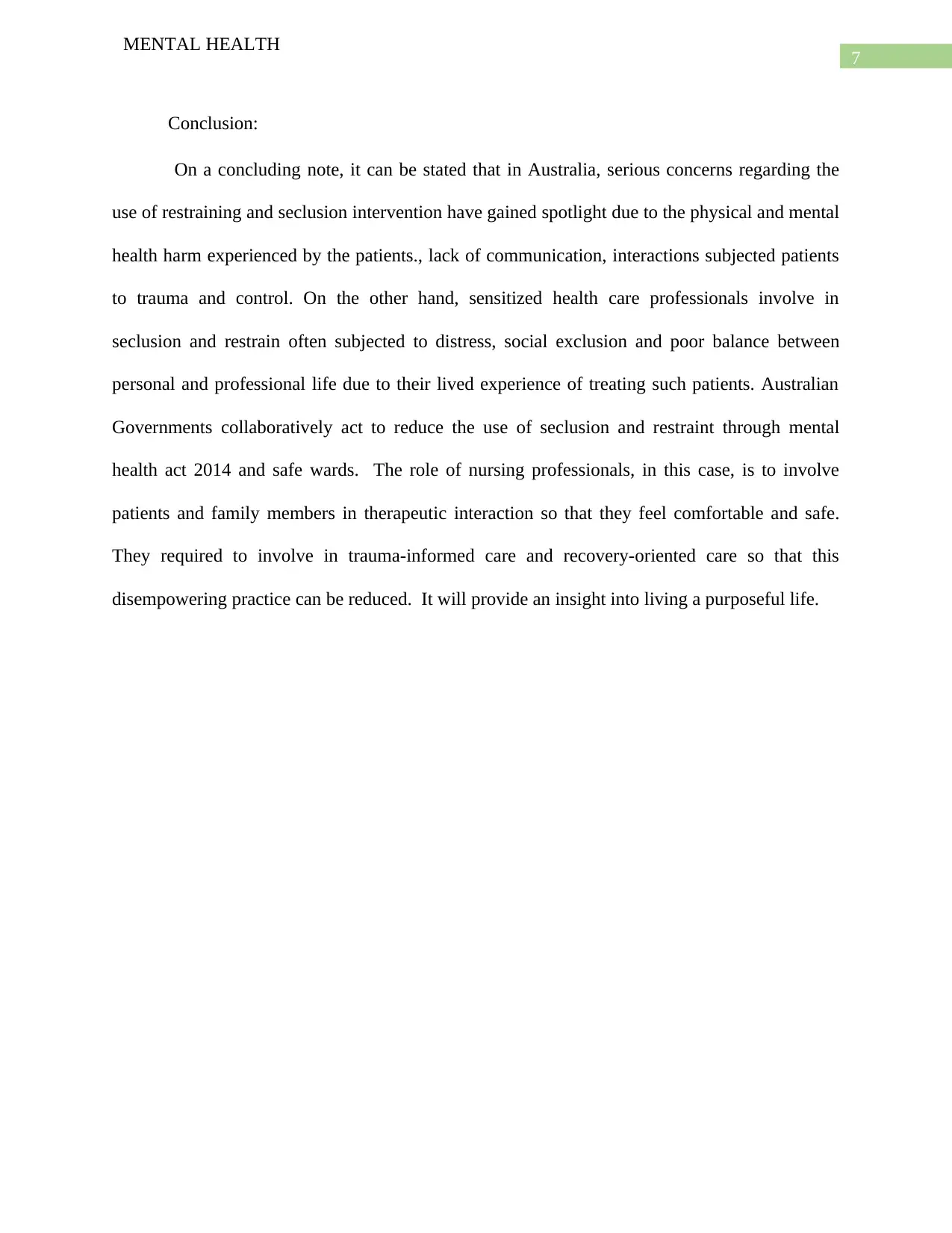
7
MENTAL HEALTH
Conclusion:
On a concluding note, it can be stated that in Australia, serious concerns regarding the
use of restraining and seclusion intervention have gained spotlight due to the physical and mental
health harm experienced by the patients., lack of communication, interactions subjected patients
to trauma and control. On the other hand, sensitized health care professionals involve in
seclusion and restrain often subjected to distress, social exclusion and poor balance between
personal and professional life due to their lived experience of treating such patients. Australian
Governments collaboratively act to reduce the use of seclusion and restraint through mental
health act 2014 and safe wards. The role of nursing professionals, in this case, is to involve
patients and family members in therapeutic interaction so that they feel comfortable and safe.
They required to involve in trauma-informed care and recovery-oriented care so that this
disempowering practice can be reduced. It will provide an insight into living a purposeful life.
MENTAL HEALTH
Conclusion:
On a concluding note, it can be stated that in Australia, serious concerns regarding the
use of restraining and seclusion intervention have gained spotlight due to the physical and mental
health harm experienced by the patients., lack of communication, interactions subjected patients
to trauma and control. On the other hand, sensitized health care professionals involve in
seclusion and restrain often subjected to distress, social exclusion and poor balance between
personal and professional life due to their lived experience of treating such patients. Australian
Governments collaboratively act to reduce the use of seclusion and restraint through mental
health act 2014 and safe wards. The role of nursing professionals, in this case, is to involve
patients and family members in therapeutic interaction so that they feel comfortable and safe.
They required to involve in trauma-informed care and recovery-oriented care so that this
disempowering practice can be reduced. It will provide an insight into living a purposeful life.
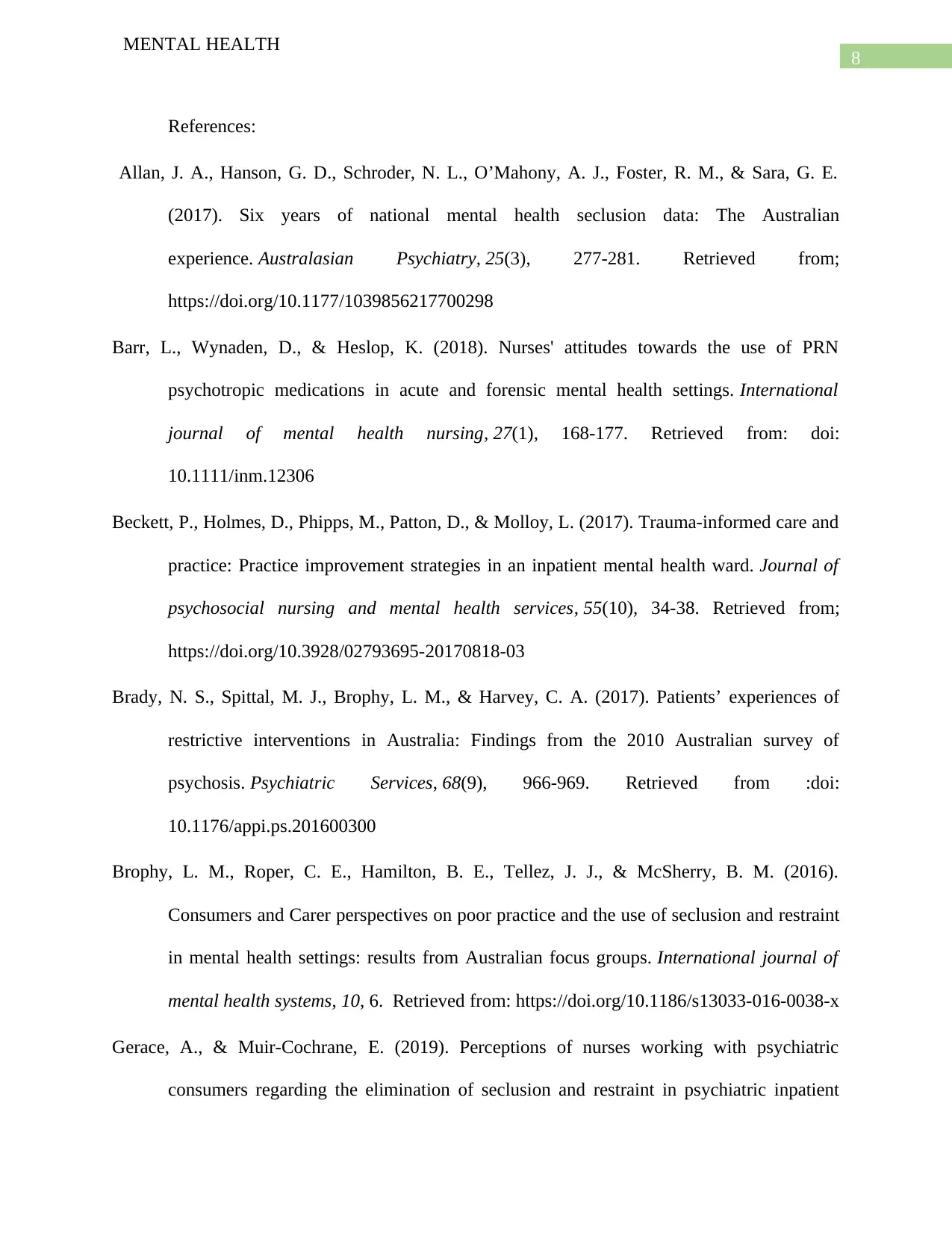
8
MENTAL HEALTH
References:
Allan, J. A., Hanson, G. D., Schroder, N. L., O’Mahony, A. J., Foster, R. M., & Sara, G. E.
(2017). Six years of national mental health seclusion data: The Australian
experience. Australasian Psychiatry, 25(3), 277-281. Retrieved from;
https://doi.org/10.1177/1039856217700298
Barr, L., Wynaden, D., & Heslop, K. (2018). Nurses' attitudes towards the use of PRN
psychotropic medications in acute and forensic mental health settings. International
journal of mental health nursing, 27(1), 168-177. Retrieved from: doi:
10.1111/inm.12306
Beckett, P., Holmes, D., Phipps, M., Patton, D., & Molloy, L. (2017). Trauma-informed care and
practice: Practice improvement strategies in an inpatient mental health ward. Journal of
psychosocial nursing and mental health services, 55(10), 34-38. Retrieved from;
https://doi.org/10.3928/02793695-20170818-03
Brady, N. S., Spittal, M. J., Brophy, L. M., & Harvey, C. A. (2017). Patients’ experiences of
restrictive interventions in Australia: Findings from the 2010 Australian survey of
psychosis. Psychiatric Services, 68(9), 966-969. Retrieved from :doi:
10.1176/appi.ps.201600300
Brophy, L. M., Roper, C. E., Hamilton, B. E., Tellez, J. J., & McSherry, B. M. (2016).
Consumers and Carer perspectives on poor practice and the use of seclusion and restraint
in mental health settings: results from Australian focus groups. International journal of
mental health systems, 10, 6. Retrieved from: https://doi.org/10.1186/s13033-016-0038-x
Gerace, A., & Muir‐Cochrane, E. (2019). Perceptions of nurses working with psychiatric
consumers regarding the elimination of seclusion and restraint in psychiatric inpatient
MENTAL HEALTH
References:
Allan, J. A., Hanson, G. D., Schroder, N. L., O’Mahony, A. J., Foster, R. M., & Sara, G. E.
(2017). Six years of national mental health seclusion data: The Australian
experience. Australasian Psychiatry, 25(3), 277-281. Retrieved from;
https://doi.org/10.1177/1039856217700298
Barr, L., Wynaden, D., & Heslop, K. (2018). Nurses' attitudes towards the use of PRN
psychotropic medications in acute and forensic mental health settings. International
journal of mental health nursing, 27(1), 168-177. Retrieved from: doi:
10.1111/inm.12306
Beckett, P., Holmes, D., Phipps, M., Patton, D., & Molloy, L. (2017). Trauma-informed care and
practice: Practice improvement strategies in an inpatient mental health ward. Journal of
psychosocial nursing and mental health services, 55(10), 34-38. Retrieved from;
https://doi.org/10.3928/02793695-20170818-03
Brady, N. S., Spittal, M. J., Brophy, L. M., & Harvey, C. A. (2017). Patients’ experiences of
restrictive interventions in Australia: Findings from the 2010 Australian survey of
psychosis. Psychiatric Services, 68(9), 966-969. Retrieved from :doi:
10.1176/appi.ps.201600300
Brophy, L. M., Roper, C. E., Hamilton, B. E., Tellez, J. J., & McSherry, B. M. (2016).
Consumers and Carer perspectives on poor practice and the use of seclusion and restraint
in mental health settings: results from Australian focus groups. International journal of
mental health systems, 10, 6. Retrieved from: https://doi.org/10.1186/s13033-016-0038-x
Gerace, A., & Muir‐Cochrane, E. (2019). Perceptions of nurses working with psychiatric
consumers regarding the elimination of seclusion and restraint in psychiatric inpatient
⊘ This is a preview!⊘
Do you want full access?
Subscribe today to unlock all pages.

Trusted by 1+ million students worldwide
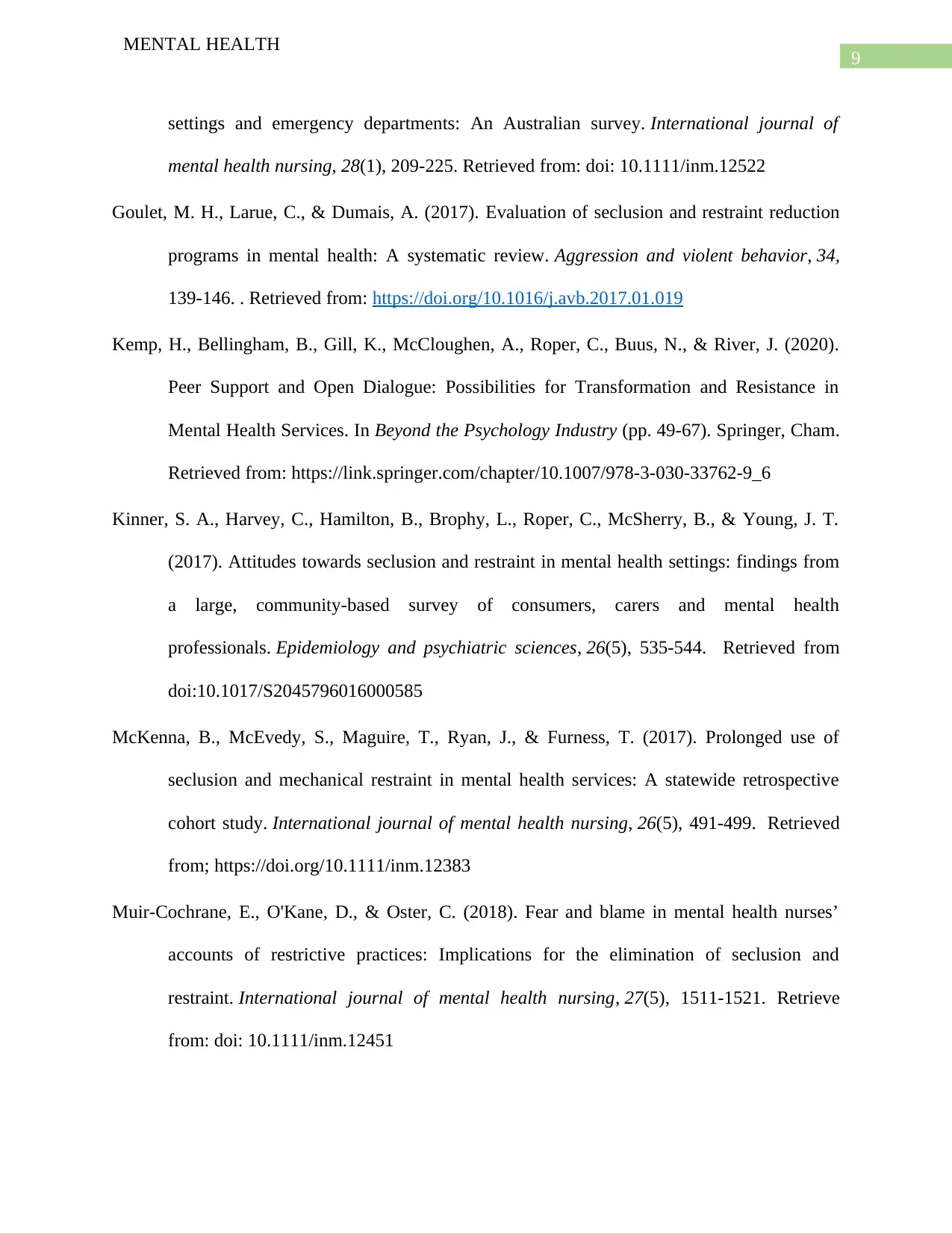
9
MENTAL HEALTH
settings and emergency departments: An Australian survey. International journal of
mental health nursing, 28(1), 209-225. Retrieved from: doi: 10.1111/inm.12522
Goulet, M. H., Larue, C., & Dumais, A. (2017). Evaluation of seclusion and restraint reduction
programs in mental health: A systematic review. Aggression and violent behavior, 34,
139-146. . Retrieved from: https://doi.org/10.1016/j.avb.2017.01.019
Kemp, H., Bellingham, B., Gill, K., McCloughen, A., Roper, C., Buus, N., & River, J. (2020).
Peer Support and Open Dialogue: Possibilities for Transformation and Resistance in
Mental Health Services. In Beyond the Psychology Industry (pp. 49-67). Springer, Cham.
Retrieved from: https://link.springer.com/chapter/10.1007/978-3-030-33762-9_6
Kinner, S. A., Harvey, C., Hamilton, B., Brophy, L., Roper, C., McSherry, B., & Young, J. T.
(2017). Attitudes towards seclusion and restraint in mental health settings: findings from
a large, community-based survey of consumers, carers and mental health
professionals. Epidemiology and psychiatric sciences, 26(5), 535-544. Retrieved from
doi:10.1017/S2045796016000585
McKenna, B., McEvedy, S., Maguire, T., Ryan, J., & Furness, T. (2017). Prolonged use of
seclusion and mechanical restraint in mental health services: A statewide retrospective
cohort study. International journal of mental health nursing, 26(5), 491-499. Retrieved
from; https://doi.org/10.1111/inm.12383
Muir‐Cochrane, E., O'Kane, D., & Oster, C. (2018). Fear and blame in mental health nurses’
accounts of restrictive practices: Implications for the elimination of seclusion and
restraint. International journal of mental health nursing, 27(5), 1511-1521. Retrieve
from: doi: 10.1111/inm.12451
MENTAL HEALTH
settings and emergency departments: An Australian survey. International journal of
mental health nursing, 28(1), 209-225. Retrieved from: doi: 10.1111/inm.12522
Goulet, M. H., Larue, C., & Dumais, A. (2017). Evaluation of seclusion and restraint reduction
programs in mental health: A systematic review. Aggression and violent behavior, 34,
139-146. . Retrieved from: https://doi.org/10.1016/j.avb.2017.01.019
Kemp, H., Bellingham, B., Gill, K., McCloughen, A., Roper, C., Buus, N., & River, J. (2020).
Peer Support and Open Dialogue: Possibilities for Transformation and Resistance in
Mental Health Services. In Beyond the Psychology Industry (pp. 49-67). Springer, Cham.
Retrieved from: https://link.springer.com/chapter/10.1007/978-3-030-33762-9_6
Kinner, S. A., Harvey, C., Hamilton, B., Brophy, L., Roper, C., McSherry, B., & Young, J. T.
(2017). Attitudes towards seclusion and restraint in mental health settings: findings from
a large, community-based survey of consumers, carers and mental health
professionals. Epidemiology and psychiatric sciences, 26(5), 535-544. Retrieved from
doi:10.1017/S2045796016000585
McKenna, B., McEvedy, S., Maguire, T., Ryan, J., & Furness, T. (2017). Prolonged use of
seclusion and mechanical restraint in mental health services: A statewide retrospective
cohort study. International journal of mental health nursing, 26(5), 491-499. Retrieved
from; https://doi.org/10.1111/inm.12383
Muir‐Cochrane, E., O'Kane, D., & Oster, C. (2018). Fear and blame in mental health nurses’
accounts of restrictive practices: Implications for the elimination of seclusion and
restraint. International journal of mental health nursing, 27(5), 1511-1521. Retrieve
from: doi: 10.1111/inm.12451
Paraphrase This Document
Need a fresh take? Get an instant paraphrase of this document with our AI Paraphraser
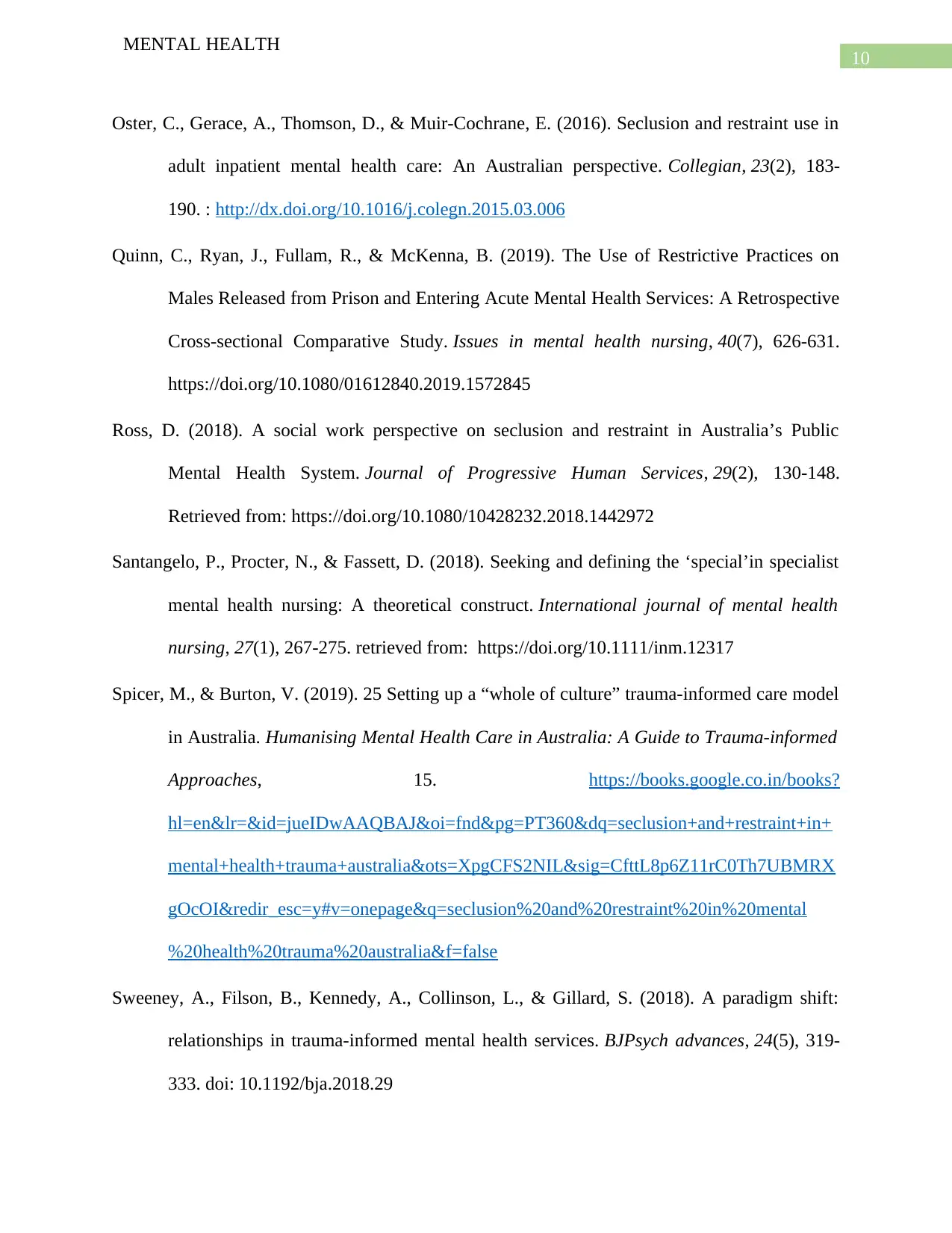
10
MENTAL HEALTH
Oster, C., Gerace, A., Thomson, D., & Muir-Cochrane, E. (2016). Seclusion and restraint use in
adult inpatient mental health care: An Australian perspective. Collegian, 23(2), 183-
190. : http://dx.doi.org/10.1016/j.colegn.2015.03.006
Quinn, C., Ryan, J., Fullam, R., & McKenna, B. (2019). The Use of Restrictive Practices on
Males Released from Prison and Entering Acute Mental Health Services: A Retrospective
Cross-sectional Comparative Study. Issues in mental health nursing, 40(7), 626-631.
https://doi.org/10.1080/01612840.2019.1572845
Ross, D. (2018). A social work perspective on seclusion and restraint in Australia’s Public
Mental Health System. Journal of Progressive Human Services, 29(2), 130-148.
Retrieved from: https://doi.org/10.1080/10428232.2018.1442972
Santangelo, P., Procter, N., & Fassett, D. (2018). Seeking and defining the ‘special’in specialist
mental health nursing: A theoretical construct. International journal of mental health
nursing, 27(1), 267-275. retrieved from: https://doi.org/10.1111/inm.12317
Spicer, M., & Burton, V. (2019). 25 Setting up a “whole of culture” trauma-informed care model
in Australia. Humanising Mental Health Care in Australia: A Guide to Trauma-informed
Approaches, 15. https://books.google.co.in/books?
hl=en&lr=&id=jueIDwAAQBAJ&oi=fnd&pg=PT360&dq=seclusion+and+restraint+in+
mental+health+trauma+australia&ots=XpgCFS2NIL&sig=CfttL8p6Z11rC0Th7UBMRX
gOcOI&redir_esc=y#v=onepage&q=seclusion%20and%20restraint%20in%20mental
%20health%20trauma%20australia&f=false
Sweeney, A., Filson, B., Kennedy, A., Collinson, L., & Gillard, S. (2018). A paradigm shift:
relationships in trauma-informed mental health services. BJPsych advances, 24(5), 319-
333. doi: 10.1192/bja.2018.29
MENTAL HEALTH
Oster, C., Gerace, A., Thomson, D., & Muir-Cochrane, E. (2016). Seclusion and restraint use in
adult inpatient mental health care: An Australian perspective. Collegian, 23(2), 183-
190. : http://dx.doi.org/10.1016/j.colegn.2015.03.006
Quinn, C., Ryan, J., Fullam, R., & McKenna, B. (2019). The Use of Restrictive Practices on
Males Released from Prison and Entering Acute Mental Health Services: A Retrospective
Cross-sectional Comparative Study. Issues in mental health nursing, 40(7), 626-631.
https://doi.org/10.1080/01612840.2019.1572845
Ross, D. (2018). A social work perspective on seclusion and restraint in Australia’s Public
Mental Health System. Journal of Progressive Human Services, 29(2), 130-148.
Retrieved from: https://doi.org/10.1080/10428232.2018.1442972
Santangelo, P., Procter, N., & Fassett, D. (2018). Seeking and defining the ‘special’in specialist
mental health nursing: A theoretical construct. International journal of mental health
nursing, 27(1), 267-275. retrieved from: https://doi.org/10.1111/inm.12317
Spicer, M., & Burton, V. (2019). 25 Setting up a “whole of culture” trauma-informed care model
in Australia. Humanising Mental Health Care in Australia: A Guide to Trauma-informed
Approaches, 15. https://books.google.co.in/books?
hl=en&lr=&id=jueIDwAAQBAJ&oi=fnd&pg=PT360&dq=seclusion+and+restraint+in+
mental+health+trauma+australia&ots=XpgCFS2NIL&sig=CfttL8p6Z11rC0Th7UBMRX
gOcOI&redir_esc=y#v=onepage&q=seclusion%20and%20restraint%20in%20mental
%20health%20trauma%20australia&f=false
Sweeney, A., Filson, B., Kennedy, A., Collinson, L., & Gillard, S. (2018). A paradigm shift:
relationships in trauma-informed mental health services. BJPsych advances, 24(5), 319-
333. doi: 10.1192/bja.2018.29
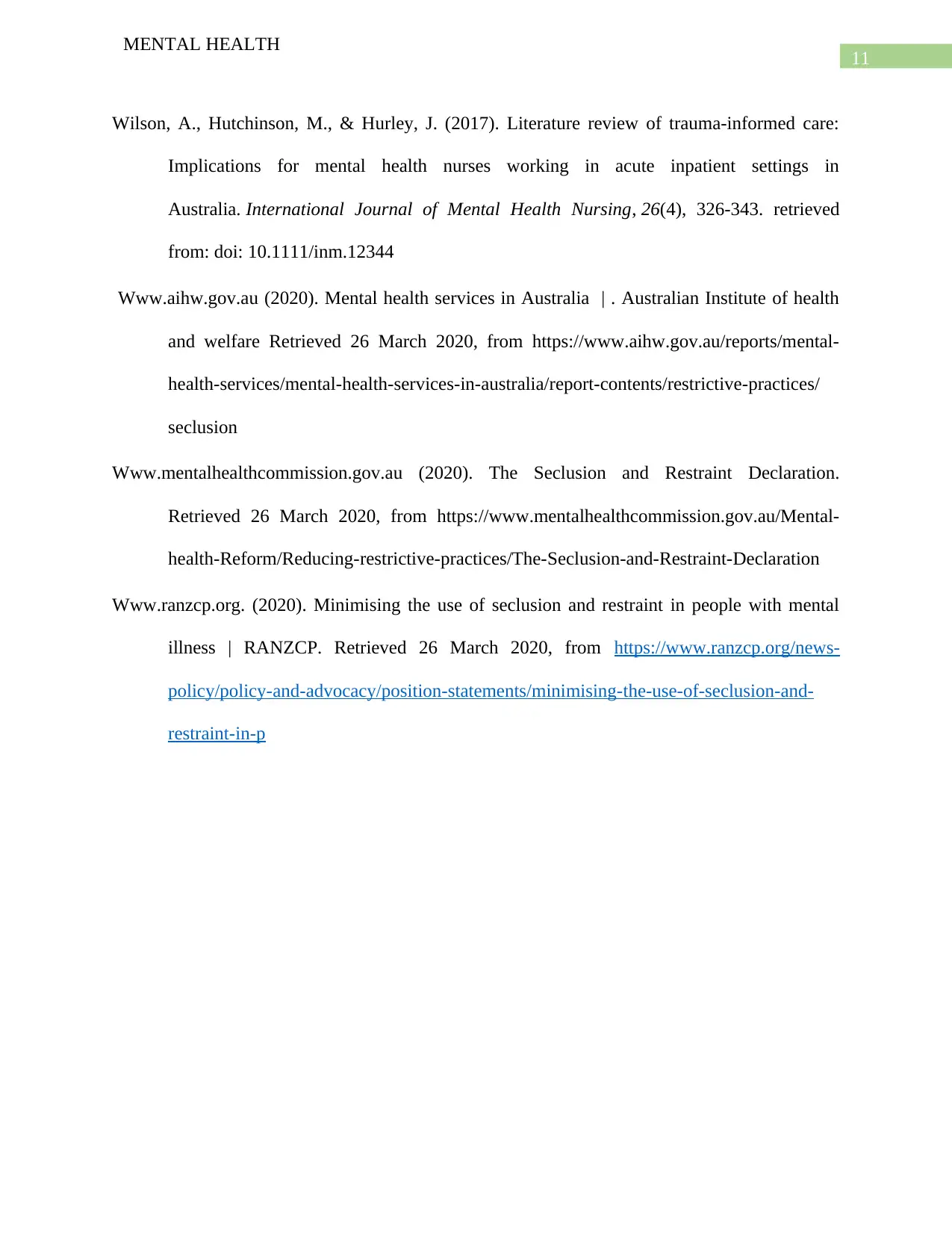
11
MENTAL HEALTH
Wilson, A., Hutchinson, M., & Hurley, J. (2017). Literature review of trauma‐informed care:
Implications for mental health nurses working in acute inpatient settings in
Australia. International Journal of Mental Health Nursing, 26(4), 326-343. retrieved
from: doi: 10.1111/inm.12344
Www.aihw.gov.au (2020). Mental health services in Australia | . Australian Institute of health
and welfare Retrieved 26 March 2020, from https://www.aihw.gov.au/reports/mental-
health-services/mental-health-services-in-australia/report-contents/restrictive-practices/
seclusion
Www.mentalhealthcommission.gov.au (2020). The Seclusion and Restraint Declaration.
Retrieved 26 March 2020, from https://www.mentalhealthcommission.gov.au/Mental-
health-Reform/Reducing-restrictive-practices/The-Seclusion-and-Restraint-Declaration
Www.ranzcp.org. (2020). Minimising the use of seclusion and restraint in people with mental
illness | RANZCP. Retrieved 26 March 2020, from https://www.ranzcp.org/news-
policy/policy-and-advocacy/position-statements/minimising-the-use-of-seclusion-and-
restraint-in-p
MENTAL HEALTH
Wilson, A., Hutchinson, M., & Hurley, J. (2017). Literature review of trauma‐informed care:
Implications for mental health nurses working in acute inpatient settings in
Australia. International Journal of Mental Health Nursing, 26(4), 326-343. retrieved
from: doi: 10.1111/inm.12344
Www.aihw.gov.au (2020). Mental health services in Australia | . Australian Institute of health
and welfare Retrieved 26 March 2020, from https://www.aihw.gov.au/reports/mental-
health-services/mental-health-services-in-australia/report-contents/restrictive-practices/
seclusion
Www.mentalhealthcommission.gov.au (2020). The Seclusion and Restraint Declaration.
Retrieved 26 March 2020, from https://www.mentalhealthcommission.gov.au/Mental-
health-Reform/Reducing-restrictive-practices/The-Seclusion-and-Restraint-Declaration
Www.ranzcp.org. (2020). Minimising the use of seclusion and restraint in people with mental
illness | RANZCP. Retrieved 26 March 2020, from https://www.ranzcp.org/news-
policy/policy-and-advocacy/position-statements/minimising-the-use-of-seclusion-and-
restraint-in-p
⊘ This is a preview!⊘
Do you want full access?
Subscribe today to unlock all pages.

Trusted by 1+ million students worldwide
1 out of 12
Related Documents
Your All-in-One AI-Powered Toolkit for Academic Success.
+13062052269
info@desklib.com
Available 24*7 on WhatsApp / Email
![[object Object]](/_next/static/media/star-bottom.7253800d.svg)
Unlock your academic potential
Copyright © 2020–2025 A2Z Services. All Rights Reserved. Developed and managed by ZUCOL.





